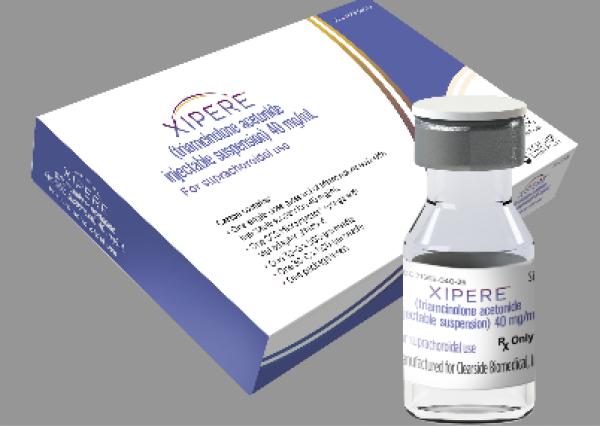Triamcinolone Ophthalmic Dosage
Medically reviewed by Drugs.com. Last updated on Dec 9, 2024.
Applies to the following strengths: 40 mg/mL
Usual Adult Dose for:
Usual Pediatric Dose for:
Additional dosage information:
Usual Adult Dose for Uveitis
4 mg (100 microliters of 40 mg/mL suspension) with subsequent dosage as needed over the course of treatment
Comments:
- Strict aseptic technique is mandatory.
- The vial should be vigorously shaken for 10 seconds before use.
- Prior to withdrawal, the suspension should be inspected for clumping or granular appearance (agglomeration).
- After withdrawal, the suspension should be injected without delay.
- Careful technique should be employed to avoid the possibility of entering a blood vessel or introducing organisms that can cause infection.
Uses:
- Treatment of sympathetic ophthalmia
- Treatment of temporal arteritis
- Treatment of uveitis
- Treatment of ocular inflammatory conditions unresponsive to topical
Usual Adult Dose for Temporal Arteritis
4 mg (100 microliters of 40 mg/mL suspension) with subsequent dosage as needed over the course of treatment
Comments:
- Strict aseptic technique is mandatory.
- The vial should be vigorously shaken for 10 seconds before use.
- Prior to withdrawal, the suspension should be inspected for clumping or granular appearance (agglomeration).
- After withdrawal, the suspension should be injected without delay.
- Careful technique should be employed to avoid the possibility of entering a blood vessel or introducing organisms that can cause infection.
Uses:
- Treatment of sympathetic ophthalmia
- Treatment of temporal arteritis
- Treatment of uveitis
- Treatment of ocular inflammatory conditions unresponsive to topical
Usual Adult Dose for Vitrectomy
1 to 4 mg (25 to 100 microliters of 40 mg/mL suspension) administered intravitreally
Comments:
- Strict aseptic technique is mandatory.
- The vial should be vigorously shaken for 10 seconds before use.
- Prior to withdrawal, the suspension should be inspected for clumping or granular appearance (agglomeration).
- After withdrawal, the suspension should be injected without delay.
- Careful technique should be employed to avoid the possibility of entering a blood vessel or introducing organisms that can cause infection.
Use: Visualization during vitrectomy
Usual Pediatric Dose for Uveitis
4 mg (100 microliters of 40 mg/mL suspension) with subsequent dosage as needed over the course of treatment
Comments:
- Strict aseptic technique is mandatory.
- The vial should be vigorously shaken for 10 seconds before use.
- Prior to withdrawal, the suspension should be inspected for clumping or granular appearance (agglomeration).
- After withdrawal, the suspension should be injected without delay.
- Careful technique should be employed to avoid the possibility of entering a blood vessel or introducing organisms that can cause infection.
Uses:
- Treatment of sympathetic ophthalmia
- Treatment of temporal arteritis
- Treatment of uveitis
- Treatment of ocular inflammatory conditions unresponsive to topical
Usual Pediatric Dose for Temporal Arteritis
4 mg (100 microliters of 40 mg/mL suspension) with subsequent dosage as needed over the course of treatment
Comments:
- Strict aseptic technique is mandatory.
- The vial should be vigorously shaken for 10 seconds before use.
- Prior to withdrawal, the suspension should be inspected for clumping or granular appearance (agglomeration).
- After withdrawal, the suspension should be injected without delay.
- Careful technique should be employed to avoid the possibility of entering a blood vessel or introducing organisms that can cause infection.
Uses:
- Treatment of sympathetic ophthalmia
- Treatment of temporal arteritis
- Treatment of uveitis
- Treatment of ocular inflammatory conditions unresponsive to topical
Usual Pediatric Dose for Vitrectomy
1 to 4 mg (25 to 100 microliters of 40 mg/mL suspension) administered intravitreally
Comments:
- Strict aseptic technique is mandatory.
- The vial should be vigorously shaken for 10 seconds before use.
- Prior to withdrawal, the suspension should be inspected for clumping or granular appearance (agglomeration).
- After withdrawal, the suspension should be injected without delay.
- Careful technique should be employed to avoid the possibility of entering a blood vessel or introducing organisms that can cause infection.
Use: Visualization during vitrectomy
Renal Dose Adjustments
Renal insufficiency: Use with caution
Liver Dose Adjustments
Data not available
Precautions
Consult WARNINGS section for additional precautions.
Dialysis
Data not available
Other Comments
Administration advice:
- The manufacturer product information should be consulted.
Storage requirements:
- Do not freeze.
- Protect from light.
More about triamcinolone ophthalmic
- Check interactions
- Compare alternatives
- Reviews (1)
- Side effects
- During pregnancy
- Drug class: ophthalmic steroids
- Breastfeeding
- En español
Patient resources
Other brands
Professional resources
Other brands
Related treatment guides
See also:
Further information
Always consult your healthcare provider to ensure the information displayed on this page applies to your personal circumstances.


